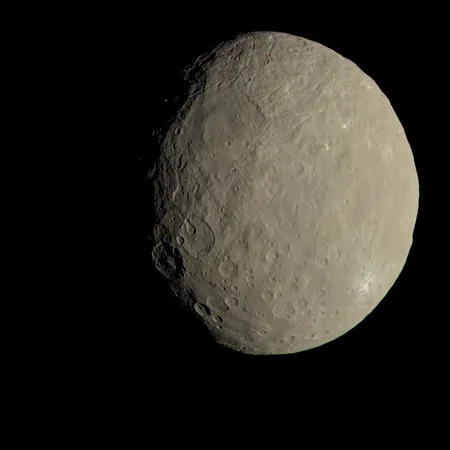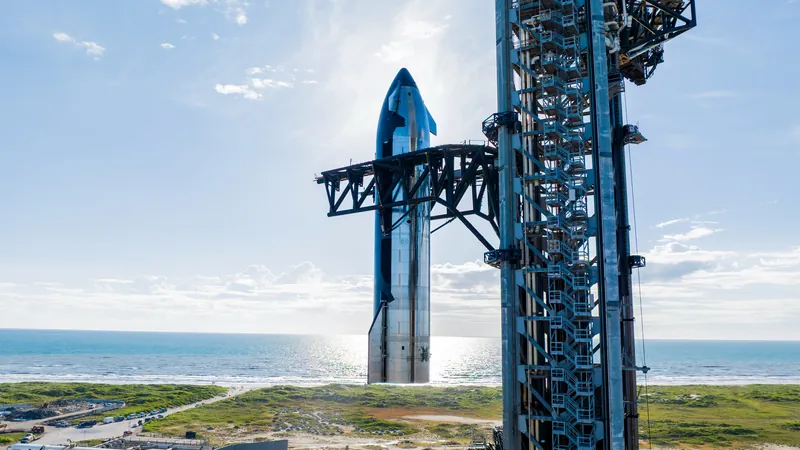
Unveiling Ceres: A Formerly Habitable World?
2025-09-17
Author: John Tan
Exploring the Potential of Ceres' Past
A groundbreaking NASA study reveals that Ceres, the largest object in the main asteroid belt, may have once had the conditions necessary to support life. Findings from the Dawn mission suggest this dwarf planet was home to a deep, enduring energy source, critical for sustaining a habitable environment in its distant past.
A Triad of Life's Ingredients Found
Published in the journal Science Advances, the research builds on previous discoveries of liquid water and essential organic molecules in Ceres' subsurface brine. This new study identifies a viable energy source that, while not proving life ever existed there, reinforces theories that microbial organisms could have thrived under its icy surface.
Ceres: The Cold Giant with a Fiery Past
Measuring about 585 miles (940 kilometers) in diameter, Ceres has captivated scientists with its unexpectedly rich water content. Today, its icy exterior belies a warmer, more dynamic history. "When hot water from deep underground mixes with the ocean, it's like a buffet for microbes," says Sam Courville, the study's lead author and a planetary scientist at NASA's Jet Propulsion Laboratory. Understanding whether Ceres had a similar hydrothermal history could reshape our understanding of potential life beyond Earth.
Energy Sources from the Depths
Using advanced thermal and chemical models, researchers simulated Ceres' evolution over billions of years. They found that radioactive decay in its rocky core could have heated the planet to over 550 Kelvin (approximately 530°F). This intense heat may have led to thermal metamorphism, releasing hot, mineral-rich fluids that mixed with the existing subsurface ocean, creating the ideal chemical environment for life.
A Brief Yet Promising Habitable Era
This potentially habitable phase is believed to have occurred between 2.5 to 4 billion years ago, possibly lasting hundreds of millions of years, as Ceres’ core reached temperatures of up to 800 Kelvin (around 980°F). Unfortunately, as the heat source diminished over time, so did the potential for hydrothermal activity, resulting in a cooling and eventual freezing of the subsurface ocean.
The Legacy of NASA's Dawn Mission
The revelations about Ceres stem from NASA's Dawn mission, launched in 2007 and the first to orbit two deep-space bodies. Its discoveries, including bright salt deposits in Occator Crater, provided pivotal information about Ceres’ watery interior. Even though the mission concluded in 2018, scientists continue to analyze its rich data, expanding our understanding of not just Ceres, but potentially other water-rich worlds in our solar system that might have also hosted life.
Ceres and Beyond: The Search for Life Continues
While the study doesn't confirm that life once existed on Ceres, it highlights that this dwarf planet had the fundamental ingredients for life—liquid water, organic materials, and a reliable energy source. As we delve deeper into Ceres’ history, we are reminded that the cosmos might hold more secrets about the conditions suitable for life than we ever imagined.



 Brasil (PT)
Brasil (PT)
 Canada (EN)
Canada (EN)
 Chile (ES)
Chile (ES)
 Česko (CS)
Česko (CS)
 대한민국 (KO)
대한민국 (KO)
 España (ES)
España (ES)
 France (FR)
France (FR)
 Hong Kong (EN)
Hong Kong (EN)
 Italia (IT)
Italia (IT)
 日本 (JA)
日本 (JA)
 Magyarország (HU)
Magyarország (HU)
 Norge (NO)
Norge (NO)
 Polska (PL)
Polska (PL)
 Schweiz (DE)
Schweiz (DE)
 Singapore (EN)
Singapore (EN)
 Sverige (SV)
Sverige (SV)
 Suomi (FI)
Suomi (FI)
 Türkiye (TR)
Türkiye (TR)
 الإمارات العربية المتحدة (AR)
الإمارات العربية المتحدة (AR)